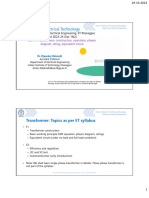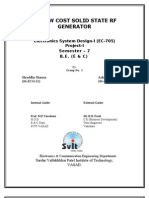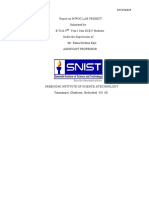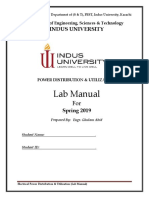0 ratings0% found this document useful (0 votes)
40 viewsEc331 2013 24 PDF
Ec331 2013 24 PDF
Uploaded by
Shah RukhThe document is a lesson on transmission line impedance matching from Dr. M.V. Kartikeyan of the Department of Electronics and Communication Engineering at Indian Institute of Technology Roorkee. It discusses using double stubs and quarter wave transformers to match transmission lines to different load impedances. The double stub method uses two permanently attached stubs of variable length to tune the impedance matching. A quarter wave transformer gradually transforms the impedance over a quarter wavelength section of transmission line. The lesson also provides examples and problems for students to practice design and analysis of transmission line matching networks.
Copyright:
© All Rights Reserved
Available Formats
Download as PDF, TXT or read online from Scribd
Ec331 2013 24 PDF
Ec331 2013 24 PDF
Uploaded by
Shah Rukh0 ratings0% found this document useful (0 votes)
40 views30 pagesThe document is a lesson on transmission line impedance matching from Dr. M.V. Kartikeyan of the Department of Electronics and Communication Engineering at Indian Institute of Technology Roorkee. It discusses using double stubs and quarter wave transformers to match transmission lines to different load impedances. The double stub method uses two permanently attached stubs of variable length to tune the impedance matching. A quarter wave transformer gradually transforms the impedance over a quarter wavelength section of transmission line. The lesson also provides examples and problems for students to practice design and analysis of transmission line matching networks.
Original Title
EC331_2013_24.pdf
Copyright
© © All Rights Reserved
Available Formats
PDF, TXT or read online from Scribd
Share this document
Did you find this document useful?
Is this content inappropriate?
The document is a lesson on transmission line impedance matching from Dr. M.V. Kartikeyan of the Department of Electronics and Communication Engineering at Indian Institute of Technology Roorkee. It discusses using double stubs and quarter wave transformers to match transmission lines to different load impedances. The double stub method uses two permanently attached stubs of variable length to tune the impedance matching. A quarter wave transformer gradually transforms the impedance over a quarter wavelength section of transmission line. The lesson also provides examples and problems for students to practice design and analysis of transmission line matching networks.
Copyright:
© All Rights Reserved
Available Formats
Download as PDF, TXT or read online from Scribd
Download as pdf or txt
0 ratings0% found this document useful (0 votes)
40 views30 pagesEc331 2013 24 PDF
Ec331 2013 24 PDF
Uploaded by
Shah RukhThe document is a lesson on transmission line impedance matching from Dr. M.V. Kartikeyan of the Department of Electronics and Communication Engineering at Indian Institute of Technology Roorkee. It discusses using double stubs and quarter wave transformers to match transmission lines to different load impedances. The double stub method uses two permanently attached stubs of variable length to tune the impedance matching. A quarter wave transformer gradually transforms the impedance over a quarter wavelength section of transmission line. The lesson also provides examples and problems for students to practice design and analysis of transmission line matching networks.
Copyright:
© All Rights Reserved
Available Formats
Download as PDF, TXT or read online from Scribd
Download as pdf or txt
You are on page 1of 30
Indian Institute of Technology Roorkee
mmthzwl
ENGINEERING ELECTROMAGNETICS
Dr. M.V. Kartikeyan
Professor
Department of Electronics & Communication Engineering
Indian Institute of Technology Roorkee
Roorkee 247 667, Uttarakhand, India
Email: kartik@iitr.ac.in / kartik@ieee.org
Kartik
MM/THz- Wave Laboratory,
Department of Electronics & Communication Engineering, IITR, Roorkee 247667, India
Indian Institute of Technology Roorkee
mmthzwl
Lesson#24
1. TL Matching (Part-02)
With double-stub
With QW transformer
Kartik
MM/THz- Wave Laboratory,
Department of Electronics & Communication Engineering, IITR, Roorkee 247667, India
Indian Institute of Technology Roorkee
RECAP ...
mmthzwl
Kartik
MM/THz- Wave Laboratory,
Department of Electronics & Communication Engineering, IITR, Roorkee 247667, India
Indian Institute of Technology Roorkee
mmthzwl
Kartik
MM/THz- Wave Laboratory,
Department of Electronics & Communication Engineering, IITR, Roorkee 247667, India
Indian Institute of Technology Roorkee
mmthzwl
Kartik
MM/THz- Wave Laboratory,
Department of Electronics & Communication Engineering, IITR, Roorkee 247667, India
Indian Institute of Technology Roorkee
mmthzwl
TUNING WITH
DOUBLE-STUB
Kartik
MM/THz- Wave Laboratory,
Department of Electronics & Communication Engineering, IITR, Roorkee 247667, India
Indian Institute of Technology Roorkee
mmthzwl
Double Stub Tuner Matching:
Suppose that the load impedance changes.
Or suppose that the transmitter is retuned
and the frequency and wavelength change.
Adjusting a single stub tuner is very difficult.
One has to remove the stub, remake the line
where the break was, and calculate the new
stub length and point of attachment.
Kartik
MM/THz- Wave Laboratory,
Department of Electronics & Communication Engineering, IITR, Roorkee 247667, India
Indian Institute of Technology Roorkee
mmthzwl
We can use two stubs permanently attached to the
line at fixed points of attachment, and tune by
altering the stub lengths.
It is comparatively easy to make sliding shorts in
rigid coaxial line. Two quantities have to be matched
(r and x) and we have two variables; the length of
each stub. (in the case of the single stub match
method, the two variables are the length of the stub,
and its position along the line with respect to the
antenna).
Kartik
MM/THz- Wave Laboratory,
Department of Electronics & Communication Engineering, IITR, Roorkee 247667, India
Indian Institute of Technology Roorkee
mmthzwl
As before, the generator-end stub has reactance -jx'
and is attached at a point where the line impedance,
including the effect of the other stub at its fixed point
of attachment, is 1+jx'. Transforming the unit r=1
circle towards the load until you reach the load-end
stub attachment, the circle r=1 transforms to another
circle, call it "B", touching the outside of the SMITH
chart, and also passing through its centre.
Kartik
MM/THz- Wave Laboratory,
Department of Electronics & Communication Engineering, IITR, Roorkee 247667, India
Indian Institute of Technology Roorkee
mmthzwl
The load impedance, when transformed towards the
generator up to the load-end stub position, will be a
generalised impedance ZL' different from ZL. The effect
of the load-end stub is to add reactance x" to ZL' so that
the impedance value ZL'+jx" lies on the circle "B" above.
We chose the length of the stub to make x" the required
value for this to happen. If we write ZL'=r'+jx' then the
effect of adding the stub is to move the reactance
j(x'+x") along the constant r' curve depending on the
size of x".
Kartik
MM/THz- Wave Laboratory,
Department of Electronics & Communication Engineering, IITR, Roorkee 247667, India
Indian Institute of Technology Roorkee
mmthzwl
Kartik
MM/THz- Wave Laboratory,
Department of Electronics & Communication Engineering, IITR, Roorkee 247667, India
Indian Institute of Technology Roorkee
mmthzwl
Kartik
MM/THz- Wave Laboratory,
Department of Electronics & Communication Engineering, IITR, Roorkee 247667, India
Indian Institute of Technology Roorkee
mmthzwl
Kartik
MM/THz- Wave Laboratory,
Department of Electronics & Communication Engineering, IITR, Roorkee 247667, India
Indian Institute of Technology Roorkee
mmthzwl
Kartik
MM/THz- Wave Laboratory,
Department of Electronics & Communication Engineering, IITR, Roorkee 247667, India
Indian Institute of Technology Roorkee
mmthzwl
Kartik
MM/THz- Wave Laboratory,
Department of Electronics & Communication Engineering, IITR, Roorkee 247667, India
Indian Institute of Technology Roorkee
mmthzwl
Triple stub tuners and E-H tuners
1. It is just possible for the r' curve not to intersect the circle "B",
in which case a double stub match is not possible for this value
of load impedance, and stub placements. Generalised
adjustable tuners are therefore designed with three stubs,
which are spaced at unequal intervals. Such a device is called a
"Triple Stub Tuner". Sliding shorts are easily arranged in coax or
waveguide.
2. In waveguide only, there is a special type of tuner called an E-H
tuner. This has shunt and series side arms consisting of sliding
shorts, attached at the same point along the guide. There is no
equivalent in 2-conductor transmission line for geometrical
reasons. An E-H tuner can always match any load impedance.
Kartik
MM/THz- Wave Laboratory,
Department of Electronics & Communication Engineering, IITR, Roorkee 247667, India
Indian Institute of Technology Roorkee
mmthzwl
Some comments based on feedback
1. Stub matching is only desirable for relatively low fractional
bandwidths. For wider bandwidth matching a multi-section
quarter wave transformer can be used, or a tapered line.
2. Impedance matching may be carried out using the SMITH
chart for calculations and design, and lumped components
taking the place of lengths of transmission line.
3. It is possible to make undesirable reflections by using a
"wrong" stub match, so care must be taken in applying stub
matching in high power (e.g. transmitting) applications. It is
always wise to measure the match before applying significant
input power.
4. In antenna matching situations significant mismatch can arise
from alterations to the near-field environment of the antenna
over time. Thus if a new antenna is added to an existing mast,
it is always wise to check the matching of the pre-existing
antennas.
Kartik
MM/THz- Wave Laboratory,
Department of Electronics & Communication Engineering, IITR, Roorkee 247667, India
Indian Institute of Technology Roorkee
mmthzwl
4. There are practical difficulties at mm wavelengths, eg on
microstrip at above 20GHz. Here, the precision of
adjustment of the lengths of the stubs needs to be 0.01
wavelengths for good quality matching.
5. At 5mm wavelength this is a precision of 50 microns.
There are also practical difficulties at high || (reflection
coefficient magnitude). Here the purpose of the stubs is
to generate an equal and opposite reflection to cancel out
the reflection from the nearly completely mismatched
load.
6. Clearly, to get effective cancellation, the stubs must be
very precisely chosen and constructed, and the fringingfield effects become important to the point that they can
dominate the design. A standard SMITH chart calculation
as in this page is then unlikely to be very effective.
Kartik
MM/THz- Wave Laboratory,
Department of Electronics & Communication Engineering, IITR, Roorkee 247667, India
Indian Institute of Technology Roorkee
mmthzwl
Kartik
MM/THz- Wave Laboratory,
Department of Electronics & Communication Engineering, IITR, Roorkee 247667, India
Indian Institute of Technology Roorkee
mmthzwl
Kartik
MM/THz- Wave Laboratory,
Department of Electronics & Communication Engineering, IITR, Roorkee 247667, India
Indian Institute of Technology Roorkee
mmthzwl
Kartik
MM/THz- Wave Laboratory,
Department of Electronics & Communication Engineering, IITR, Roorkee 247667, India
Indian Institute of Technology Roorkee
mmthzwl
Kartik
MM/THz- Wave Laboratory,
Department of Electronics & Communication Engineering, IITR, Roorkee 247667, India
Indian Institute of Technology Roorkee
mmthzwl
Kartik
MM/THz- Wave Laboratory,
Department of Electronics & Communication Engineering, IITR, Roorkee 247667, India
Indian Institute of Technology Roorkee
mmthzwl
Kartik
MM/THz- Wave Laboratory,
Department of Electronics & Communication Engineering, IITR, Roorkee 247667, India
Indian Institute of Technology Roorkee
mmthzwl
PROBLEM
Kartik
MM/THz- Wave Laboratory,
Department of Electronics & Communication Engineering, IITR, Roorkee 247667, India
Indian Institute of Technology Roorkee
mmthzwl
Quarter Wave Transformer
Kartik
MM/THz- Wave Laboratory,
Department of Electronics & Communication Engineering, IITR, Roorkee 247667, India
Indian Institute of Technology Roorkee
mmthzwl
Kartik
MM/THz- Wave Laboratory,
Department of Electronics & Communication Engineering, IITR, Roorkee 247667, India
Indian Institute of Technology Roorkee
mmthzwl
Kartik
MM/THz- Wave Laboratory,
Department of Electronics & Communication Engineering, IITR, Roorkee 247667, India
Indian Institute of Technology Roorkee
mmthzwl
Kartik
MM/THz- Wave Laboratory,
Department of Electronics & Communication Engineering, IITR, Roorkee 247667, India
Indian Institute of Technology Roorkee
mmthzwl
Kartik
MM/THz- Wave Laboratory,
Department of Electronics & Communication Engineering, IITR, Roorkee 247667, India
You might also like
- En 13445-5Document65 pagesEn 13445-5VIJAYAKUMAR T28% (18)
- EnQuest - Managing Uncertainty in A Mature North Sea Field Through Ensemble ModellingDocument13 pagesEnQuest - Managing Uncertainty in A Mature North Sea Field Through Ensemble ModellingMoeNo ratings yet
- Automated Broad and Narrow Band Impedance Matching for RF and Microwave CircuitsFrom EverandAutomated Broad and Narrow Band Impedance Matching for RF and Microwave CircuitsNo ratings yet
- Academic Research and WritingDocument9 pagesAcademic Research and Writingmd. sharshahNo ratings yet
- Engagement Letter FormatDocument7 pagesEngagement Letter FormatSyed Mohammad Neyaz HasnainNo ratings yet
- Ec331 2013 12 PDFDocument42 pagesEc331 2013 12 PDFShah RukhNo ratings yet
- Ec331 2013 18 PDFDocument26 pagesEc331 2013 18 PDFShah RukhNo ratings yet
- Ec331 2013 25 PDFDocument77 pagesEc331 2013 25 PDFShah RukhNo ratings yet
- Ec331 2013 13 PDFDocument45 pagesEc331 2013 13 PDFShah RukhNo ratings yet
- Ec331 2013 11 PDFDocument35 pagesEc331 2013 11 PDFShah RukhNo ratings yet
- Ec331 2013 16 PDFDocument18 pagesEc331 2013 16 PDFShah RukhNo ratings yet
- Ec331 2013 20 PDFDocument19 pagesEc331 2013 20 PDFShah RukhNo ratings yet
- Ec331 2013 19 PDFDocument13 pagesEc331 2013 19 PDFShah RukhNo ratings yet
- Ec331 2013 29 PDFDocument34 pagesEc331 2013 29 PDFShah RukhNo ratings yet
- Ec331 2013 27 PDFDocument48 pagesEc331 2013 27 PDFShah RukhNo ratings yet
- Ec331 2013 23 PDFDocument29 pagesEc331 2013 23 PDFShah RukhNo ratings yet
- Ec331 2013 22 PDFDocument35 pagesEc331 2013 22 PDFShah RukhNo ratings yet
- Ec331 2013 17 PDFDocument19 pagesEc331 2013 17 PDFShah RukhNo ratings yet
- Ec331 2013 30 PDFDocument46 pagesEc331 2013 30 PDFShah RukhNo ratings yet
- Ec331 2013 14 PDFDocument18 pagesEc331 2013 14 PDFShah RukhNo ratings yet
- Ec331 2013 03 PDFDocument51 pagesEc331 2013 03 PDFShah RukhNo ratings yet
- Ec331 2013 09 PDFDocument30 pagesEc331 2013 09 PDFShah RukhNo ratings yet
- Ec331 2013 06 PDFDocument30 pagesEc331 2013 06 PDFShah RukhNo ratings yet
- Ec331 2013 07 PDFDocument36 pagesEc331 2013 07 PDFShah RukhNo ratings yet
- Ec334 Les 2012 12Document29 pagesEc334 Les 2012 12Khatri RaviNo ratings yet
- Ec331 2013 08 PDFDocument26 pagesEc331 2013 08 PDFShah RukhNo ratings yet
- Ec#102: Fundamentals of Electronics Ec#102: Fundamentals of ElectronicsDocument20 pagesEc#102: Fundamentals of Electronics Ec#102: Fundamentals of Electronicsishuverma504No ratings yet
- Ec332 Les Mwssd02Document14 pagesEc332 Les Mwssd02Khatri RaviNo ratings yet
- Ec332 Les Mwa02Document19 pagesEc332 Les Mwa02Khatri RaviNo ratings yet
- EC#332 RF Receiver Design (MWA01)Document12 pagesEC#332 RF Receiver Design (MWA01)Khatri RaviNo ratings yet
- Ec#102: Fundamentals of Electronics Ec#102: Fundamentals of ElectronicsDocument20 pagesEc#102: Fundamentals of Electronics Ec#102: Fundamentals of Electronicsishuverma504No ratings yet
- ECN#531: Microwave Engineering ECN#531: Microwave EngineeringDocument17 pagesECN#531: Microwave Engineering ECN#531: Microwave Engineeringgate signalsNo ratings yet
- ImpedancematchingDocument17 pagesImpedancematchingRamya RNo ratings yet
- Impedancematchingsoniasharma PDFDocument17 pagesImpedancematchingsoniasharma PDFsubuhpramonoNo ratings yet
- Electrical Handbook Formula Book SampleDocument73 pagesElectrical Handbook Formula Book Samplesnitin26100% (4)
- IJCRT2403900Document7 pagesIJCRT2403900Qafaat TechNo ratings yet
- GRT Institute of Engineering and Technology, TiruttaniDocument230 pagesGRT Institute of Engineering and Technology, TiruttaniparantnNo ratings yet
- Patch Antenna Design at 2.4GHz FRQDocument17 pagesPatch Antenna Design at 2.4GHz FRQImtiaz Ali100% (1)
- (ST) LecF1 EE11003 ET Transformer 30-31.10.23Document18 pages(ST) LecF1 EE11003 ET Transformer 30-31.10.23theyanesherNo ratings yet
- Design and Study of QWT FED Microstrip Patch Antenna at 6.5 GHZ ApplicationDocument3 pagesDesign and Study of QWT FED Microstrip Patch Antenna at 6.5 GHZ ApplicationEditor IJRITCCNo ratings yet
- Final Synopsis Format HP 2018Document19 pagesFinal Synopsis Format HP 2018mradurajeNo ratings yet
- CIA II RevisedDocument65 pagesCIA II Revisedviswa2997No ratings yet
- Home Automation Using LabviewDocument4 pagesHome Automation Using LabviewIJSTENo ratings yet
- 5K9 Line Follower Using DC MotorDocument19 pages5K9 Line Follower Using DC Motorbuleberry73No ratings yet
- RL - RC Final Project Report Sauarabh KumarDocument24 pagesRL - RC Final Project Report Sauarabh KumarsaurabhthegeNo ratings yet
- Design of A 85 GHZ Rotary Traveling Wave Oscillator For Imaging ApplicationsDocument4 pagesDesign of A 85 GHZ Rotary Traveling Wave Oscillator For Imaging ApplicationsEditor IJRITCCNo ratings yet
- Triboelectric Rotational Speed Sensor Integrated IDocument8 pagesTriboelectric Rotational Speed Sensor Integrated Itomarabhaysingh868No ratings yet
- Design and Simulation of Tri Band Aperture Coupled Feed Microstrip Antenna For Its Application To Filtering AntennaDocument19 pagesDesign and Simulation of Tri Band Aperture Coupled Feed Microstrip Antenna For Its Application To Filtering Antennavbv sharmaNo ratings yet
- Fu_2019_J._Phys. _Conf._Ser._1345_032095Document7 pagesFu_2019_J._Phys. _Conf._Ser._1345_032095kenig32No ratings yet
- Complete Project Report On Solid State RF GeneratorDocument64 pagesComplete Project Report On Solid State RF Generatorankita100% (2)
- C-Band VSAT Data Communication System and RF ImpaiDocument19 pagesC-Band VSAT Data Communication System and RF ImpaiPhilipp A IslaNo ratings yet
- Repo TitDocument10 pagesRepo TitAaditya BaidNo ratings yet
- Simulation of Faults in Long Transmission Line Using MATLAB SimulinkDocument29 pagesSimulation of Faults in Long Transmission Line Using MATLAB SimulinkKhaja SameeduddinNo ratings yet
- Static and Dynamic Edge Trigger Register Using Pass Transistor IJERTV13IS040006Document8 pagesStatic and Dynamic Edge Trigger Register Using Pass Transistor IJERTV13IS040006Prakash DNo ratings yet
- Maskless Lithography An Approach To SU-8 Based SenDocument11 pagesMaskless Lithography An Approach To SU-8 Based SenSachin SharmaNo ratings yet
- A Review of Combiner/Divider PCB Design Topologies For 5G and WiGig ATE ApplicationsDocument27 pagesA Review of Combiner/Divider PCB Design Topologies For 5G and WiGig ATE ApplicationsjalvesmoNo ratings yet
- Report On Mwoc Lab Project Submitted by B.Tech 4 Year-I Sem ECE F Students Under The Supervision of Mr. Rama Krishna Raju Assistant ProfessorDocument9 pagesReport On Mwoc Lab Project Submitted by B.Tech 4 Year-I Sem ECE F Students Under The Supervision of Mr. Rama Krishna Raju Assistant ProfessorLaasya LataNo ratings yet
- Electric Lineman Protection Using Keypad and GSM Based Circuit BreakerDocument4 pagesElectric Lineman Protection Using Keypad and GSM Based Circuit BreakerIJIERT-International Journal of Innovations in Engineering Research and TechnologyNo ratings yet
- RF Oscillator Design Aspects PDFDocument4 pagesRF Oscillator Design Aspects PDFag1tatorNo ratings yet
- MeasurementofpowerqualityDocument6 pagesMeasurementofpowerqualityEmir JusićNo ratings yet
- Power Distribution & UtilizationDocument67 pagesPower Distribution & UtilizationAnonymous 5GBBc4550% (2)
- Metal Shape Detector: A Project Report OnDocument61 pagesMetal Shape Detector: A Project Report OnAkhil VermaNo ratings yet
- Arduino Measurements in Science: Advanced Techniques and Data ProjectsFrom EverandArduino Measurements in Science: Advanced Techniques and Data ProjectsNo ratings yet
- Ec331 2013 30 PDFDocument46 pagesEc331 2013 30 PDFShah RukhNo ratings yet
- Ec331 2013 22 PDFDocument35 pagesEc331 2013 22 PDFShah RukhNo ratings yet
- Ec331 2013 27 PDFDocument48 pagesEc331 2013 27 PDFShah RukhNo ratings yet
- Ec331 2013 29 PDFDocument34 pagesEc331 2013 29 PDFShah RukhNo ratings yet
- Ec331 2013 23 PDFDocument29 pagesEc331 2013 23 PDFShah RukhNo ratings yet
- Ec331 2013 20 PDFDocument19 pagesEc331 2013 20 PDFShah RukhNo ratings yet
- Ec331 2013 21 PDFDocument38 pagesEc331 2013 21 PDFShah RukhNo ratings yet
- Ec331 2013 19 PDFDocument13 pagesEc331 2013 19 PDFShah RukhNo ratings yet
- Ec331 2013 16 PDFDocument18 pagesEc331 2013 16 PDFShah RukhNo ratings yet
- Ec331 2013 14 PDFDocument18 pagesEc331 2013 14 PDFShah RukhNo ratings yet
- Ec331 2013 17 PDFDocument19 pagesEc331 2013 17 PDFShah RukhNo ratings yet
- Ec331 2013 08 PDFDocument26 pagesEc331 2013 08 PDFShah RukhNo ratings yet
- Ec331 2013 06 PDFDocument30 pagesEc331 2013 06 PDFShah RukhNo ratings yet
- Ec331 2013 07 PDFDocument36 pagesEc331 2013 07 PDFShah RukhNo ratings yet
- Ec331 2013 09 PDFDocument30 pagesEc331 2013 09 PDFShah RukhNo ratings yet
- Ec331 2013 03 PDFDocument51 pagesEc331 2013 03 PDFShah RukhNo ratings yet
- 3 Is Narrative 1 SHERRY 1 2Document69 pages3 Is Narrative 1 SHERRY 1 2rolan b. decenaNo ratings yet
- En 16985 (2018) (E)Document9 pagesEn 16985 (2018) (E)airreshangarNo ratings yet
- Download ebooks file Imperfections in Crystalline Solids 1st Edition Wei Cai all chaptersDocument62 pagesDownload ebooks file Imperfections in Crystalline Solids 1st Edition Wei Cai all chaptersnutnutnkuah37100% (1)
- Part 2 Rqs SolvedDocument26 pagesPart 2 Rqs Solvedananth josyulaNo ratings yet
- Saving Account Advantage: Project 1 Work Effectively in The Financial Sector and Customer Account Task1.1Document3 pagesSaving Account Advantage: Project 1 Work Effectively in The Financial Sector and Customer Account Task1.1yoniakia2124No ratings yet
- DGS F1100 10PS E Datasheet Update Ver2Document4 pagesDGS F1100 10PS E Datasheet Update Ver2Abdullah MoursiNo ratings yet
- UntitledDocument3 pagesUntitledJenalyn MacarilayNo ratings yet
- 5G Technology Evolution: B,.usmonov@ Ozod@tuit - UzDocument5 pages5G Technology Evolution: B,.usmonov@ Ozod@tuit - UzJoshuaNo ratings yet
- Prezentacja PiDocument20 pagesPrezentacja PiigaNo ratings yet
- Staffing Plan Excel TemplateDocument10 pagesStaffing Plan Excel TemplateA. MughrabiNo ratings yet
- Speaking NaturallyDocument128 pagesSpeaking Naturallyapi-19731241100% (18)
- TornDocument11 pagesTornLoubna ben heddiNo ratings yet
- Business Plan Format 2024Document17 pagesBusiness Plan Format 2024Eloisa Marie dela CruzNo ratings yet
- UCC Vs Common LawDocument5 pagesUCC Vs Common LawWhitney Snyder100% (6)
- Connecting LEDs To The Parallel PortDocument3 pagesConnecting LEDs To The Parallel PortAiLeen AngeLieNo ratings yet
- Immediate download Textbook of human osteology with atlas of muscle attachments 3rd Edition Inderbir Singh ebooks 2024Document51 pagesImmediate download Textbook of human osteology with atlas of muscle attachments 3rd Edition Inderbir Singh ebooks 2024vignaatkinoeNo ratings yet
- NCERT Solutions Class 9 English Chapter 1 The Fun They HadDocument11 pagesNCERT Solutions Class 9 English Chapter 1 The Fun They HadKevin UchihaNo ratings yet
- PES5035B-2024-2025 Essay TopicsDocument6 pagesPES5035B-2024-2025 Essay Topicsbrainokeah1No ratings yet
- leveraging the patent cliffDocument121 pagesleveraging the patent cliffvallabhaneni198No ratings yet
- The Great Covid-Driven Teamwork DivideDocument3 pagesThe Great Covid-Driven Teamwork DividehidekiNo ratings yet
- Assignment HypersensitivityDocument3 pagesAssignment HypersensitivityNurzatul syamim busriNo ratings yet
- Combined Emotional Socialization Training and Family Accommodation Modification - Impact On Emotional Regulation and Anxiety Symptoms in Anxious ChildrenDocument13 pagesCombined Emotional Socialization Training and Family Accommodation Modification - Impact On Emotional Regulation and Anxiety Symptoms in Anxious Childrendecomoraes4275No ratings yet
- Subject Geology: Paper No and Title Remote Sensing and GIS Module No and Title Module TagDocument19 pagesSubject Geology: Paper No and Title Remote Sensing and GIS Module No and Title Module TagKuldeep SinghNo ratings yet
- I Love Shopping! - Students VersionDocument4 pagesI Love Shopping! - Students VersionEVDOXIANo ratings yet
- Nagaraju BachuDocument6 pagesNagaraju BachuVamsi RamuNo ratings yet
- Analytical TEXTDocument7 pagesAnalytical TEXTNafil FirdausNo ratings yet


























































































